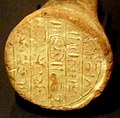Top Qs
Timeline
Chat
Perspective
Knot (hieroglyph)
Egyptian hieroglyph From Wikipedia, the free encyclopedia
Remove ads
The ancient Egyptian knot hieroglyph, or girdle knot, Gardiner sign listed no. S24, portrays a reef knot. Besides its use as a hieroglyph, it has usage in statuary and reliefs. The knot hieroglyph is also an amulet, typically made of worked stone, or as jewellery elements.[1]

Remove ads
Language usage
The knot hieroglyph is used in the Egyptian language as the verb, (th)s, (th)ss, for to knot, to tie, to tie together, etc.
It is used as the phonogram for (th)s, as well as the determinative. There are many alternate spellings. For the noun, it is Egyptian language (th)s, (th)s.t,
for meanings of: knot, tie, ligature, backbone, vertebrae, spine, etc.
In jewellery and decoration
The knot used as an article of jewellery was especially known in the Middle Kingdom. It can be found in necklaces (see gallery photo), and as a small brooch. In Amulets of Ancient Egypt, a two-part, hollow gold piece is shown, with a detailed rope-detailed fiber; it is made with a tongue and groove closure for the parts.[2]
Remove ads
Gallery
- Funerary cone using the 'girdle-knot hieroglyph'
- Small bandlet made of 16 knot-pieces
- Relief from reign of Hatshepsut
See also
Wikimedia Commons has media related to Belt knot (hieroglyph).
References
Wikiwand - on
Seamless Wikipedia browsing. On steroids.
Remove ads



